SUBJECTS
GRADE
Show Results
Storytelling Through Hoop Dance
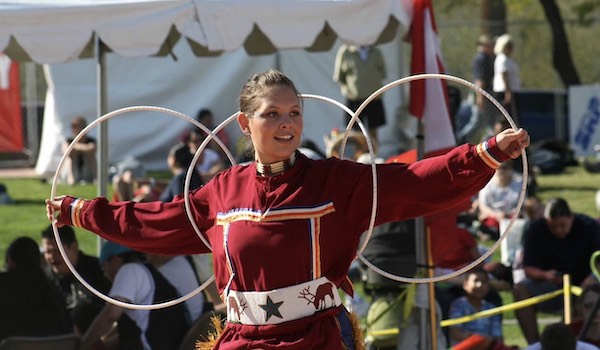
Lesson Summary
- Learn about the storytelling aspect of the Native American Hoop Dance.
- Create and perform a musical soundscape.
- Write a three-sentence narrative by focusing on story structure.
Lesson Plan and Procedure
Lesson Key Facts
- Grade(s): 3, 4, 5, 6, 7, 8, 9, 10, 11, 12
- Subject(s): Dance, English Language Arts, Music, Social Studies, Native American
- Duration of lesson: Two sessions, 45 minutes each
- Author(s): Terry Goedel, Emily Soderborg, and Mary Grace Johnson
This lesson was developed in collaboration with several Native Hoop Dancers including Michael Goedel, Terry Goedel, Patrick Willie, Meredith Little, and Kelina Anderson. While no one is certain which tribe originated Hoop Dancing, it has become an intertribal dance, meaning different tribes now do it across regions. However, we have still tried to share the individual tribal aspects of the dance where possible, reinforcing that there are many different Native tribes across North America, not just one Native American group. We hope that others will respect these Hoop Dancers’ choice to share this aspect of their culture.
Print the jigsaw materials before starting this lesson.
Session One: Introduction to Storytelling
Teacher: Do you have a favorite story? Why do you like it?
Have a brief conversation about stories.
Teacher: Why do you think humans tell and listen to stories? One reason we tell stories is to communicate in an appealing, memorable way. Storytelling is an exchange. There is a storyteller on one side and a listener on the other. Through this exchange, we are connected to each other and make meaning of the world around us. Stories become recognizable patterns, and in those patterns, we find understanding. Stories can teach us about life, about ourselves and about others, including helping us develop an understanding, respect, and appreciation for other cultures. Through stories we can promote a positive attitude towards people from different lands, races and religions.
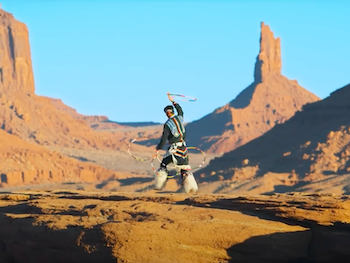 Teacher: Not all stories are told using words. Some of the greatest stories are told in a way that requires us to imagine the details and use our senses in a way different than only listening to or reading words. Today, we are going to watch a story told through movement. Our storyteller’s name is Michael Goedel. He is a descendant of the Yakama (YAK-uh-muh), Tulalip (too-LAY-lip), and Lumbee (LUHM-bee) tribes, and he is a world-famous Hoop Dancer. Native American Hoop Dancing is a form of storytelling. An Indigenous Hoop Dancer uses hoops to create shapes as they move to music. The shapes can represent animals, plants, symbols, or designs. Through these hoop formations the story is shared.
Teacher: Not all stories are told using words. Some of the greatest stories are told in a way that requires us to imagine the details and use our senses in a way different than only listening to or reading words. Today, we are going to watch a story told through movement. Our storyteller’s name is Michael Goedel. He is a descendant of the Yakama (YAK-uh-muh), Tulalip (too-LAY-lip), and Lumbee (LUHM-bee) tribes, and he is a world-famous Hoop Dancer. Native American Hoop Dancing is a form of storytelling. An Indigenous Hoop Dancer uses hoops to create shapes as they move to music. The shapes can represent animals, plants, symbols, or designs. Through these hoop formations the story is shared.
Look at still images of a few of the hoop formations the students will see in the Hoop Dance video.
Teacher: As we watch the Hoop Dance, look for these hoop formations. See if you notice any recognizable patterns that help tell the story. The Hoop Dance story Michael shares is of a young bird (an eaglet) and its life until it’s a full-grown eagle. The dance goes through the eagle’s experiences with plants and animals that help it understand its identity and purpose.
Watch the video of Michael dancing.
Teacher: What were your thoughts as you watched this dance?
Have students turn to a partner and discuss each of the following prompts.
- Which parts of the story were you able to recognize?
- What questions do you have after watching Michael dance?
Teacher: We are going to watch again. See if you notice anything different this time that you didn’t catch the first time.
Watch the dance a second time.
Hoop Dance Background
Preassign students into “home” groups of four students each. Create "expert groups" that consist of students across "home groups" who will read the same selection.
Have students gather to their “expert” groups.
- What Is Needed to Hoop Dance?
- What Does the Hoop Symbolize?
- Who Does the Hoop Dance?
- What Is the History of the Hoop Dance?
Pass out the Hoop Dance information sheets and graphic organizers. Give the “expert” groups a few minutes to read the article together and fill in the first part of the graphic organizer using words or images to remember what was read.
Teacher: As you are reading, pay attention to what you think is most interesting. What do you think your home group needs to know about your reading in order to better understand the Hoop Dance?
Gather back into "home groups" and have students teach one another the most important ideas from the text that they read.
Teacher: In your home group, everyone will have three minutes to share what they learned. I’ll let you know when you have 45 seconds left. The person who is the expert on “What is Needed to Hoop Dance” will go first. Fill in the other parts of your graphic organizer by recording the ideas using words, icons, or pictures. By the end of teaching one another, you should have responded to each section.
As a class, discuss what students learned and the questions they still have.
Hoop Dance Stories
Teacher: The Hoop Dance isn’t always done the same way, depending on the dancer’s background, and where the dance is being done. Similarly, the stories about the Hoop Dance also change. There are many stories of where the Hoop Dance originates from. Many believe the dance originated with the Taos Pueblo, while other tribal groups have also laid claim to helping originate the Hoop Dance. Although no one knows exactly when the Hoop Dance began, there are many legends that describe it. One legend describes a boy who didn’t like to do the things other boys his age liked to do, such as hunting and fishing, but instead spent hours watching animals in the wild. As he watched, the boy was able to begin copying their movements. He added the hoops to help express the animal movements and created a dance that he taught to others.
Teacher: That story is told by the Anishinaabe who are located in what is now the United States and Canada in the area surrounding the Great Lakes. In comparison, Michael Goedel is from the Yakama, Tulalip, and Lumbee tribes. The Yakama and Tulalip tribes are found in the Pacific Northwest and the Lumbee come from the Eastern Coast. The Hoop Dance is done by many, many different tribal nations and depending where a person is from shapes the story they associate with the dance.
Show a map and point out the areas where the stories come from. Seeing a map, such as the one found at https://native-land.ca can help students recognize that there are hundreds of different Native groups, each with different stories, customs, and languages. There are over 550 federally recognized tribal nations in the United States.
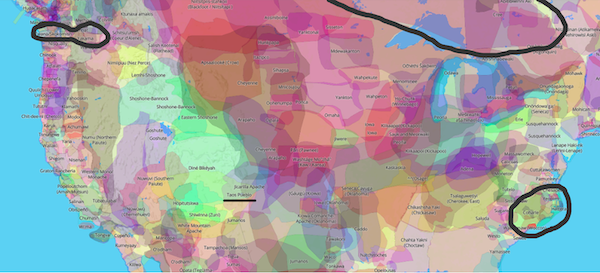
Teacher: Another legend shared in several North American Plains Indian communities tells of a “dying man” who wants to do something that others will remember and use after he is gone. The Creator, in response, gives him a single wooden hoop and tells him that for each living thing he creates with the hoop, one more hoop will be given to him. He uses his body and the hoop to create images. With each added hoop, the man miraculously grows stronger. In the end he creates the forms of all other living things.
Teacher: What do you notice about each of these stories? These are just a few of the stories associated with the Hoop Dance. While each dancer approaches it a little differently, the story told through the Hoop Dance is one of growth and life.
Story Structure
Teacher: A well-written story can take you on an exciting journey. While stories can be long or short, most have a sequence of events or a plot. This is known as story structure. When you tell a story, it's important to have a good story structure so that the audience has enough information to understand and enjoy it. There are three main parts of a story's structure: the beginning, middle, and end. We are going point out the story structure in Michael’s version of the Hoop Dance as simply as possible, using only three sentences. The first sentence will be the beginning of the story, the second sentence will be the middle, and the third sentence will be the ending.
There was once a small bird. It went on a journey and encountered many different plants and animals including a butterfly and a crocodile. Through these experiences it comes to understand its identity as a great eagle.
Session Two: Telling a Story Through a Soundscape
Review the three-sentence story shared about Michael Goedel’s Hoop Dance and then watch the video of Michael dancing again.
Teacher: Now that we have a Hoop Dance story outlined with a specific beginning, middle, and end, we can use this story structure to tell the Hoop Dance story in another way, besides using words or movement. We will use music to tell this Hoop Dance story. Have any of you heard music that told a story through only the music, not the lyrics?
Teacher: Classical music that is written to tell a story is sometimes referred to as “program music.” In program music, the composer uses only sounds, not words, to help the listener imagine the specific pictures and sequence of events in the story they are trying to tell. Modern movie soundtracks are also considered a type of program music.
Here is some information about a Native American classical composer and one of his pieces of program music:
Louis W. Ballard (1931-2007) is "known as the father of classical Native American composition." He was best known for compositions that synthesize elements of Native American and Western classical music. As a composer, he achieved international recognition and was the first American composer to have an entire program dedicated to his music in the Beethovenhalle in Bonn, West Germany (1989). His father was Cherokee, and his mother was Quapaw. Ballard spent much of his childhood on Quapaw tribal territory in northeastern Oklahoma. He was an active member of the War Dance Society of the Quapaw and participated in powwows and other events in the Native American community, and became a prize winning strait dancer. His interest in Native American dance influenced his concert works: rhythmic elements derived from powwow drumming appear in many of his works.
“Bees,” from Ballard's Katcina Dances drew inspiration from the music and dance traditions of the Hopi people Louis Ballard spent much time with. The Bee or Momo Kachina would come out during the Water Serpent Ceremony, held when the sun rises over the cliffs. In the dance, the Bee Kachina of the Hopi imitates the hum of the bee and goes from one spectator to another, shooting play arrows at them. For the children, if they get "shot", the Bee Kachina squirts water on their "wound", and gives them honey. It is important to recognize that the Hopi people are very private with their culture. For a long time you had to be invited to even witness any of the dances, and no photographs were allowed. In this work Louis Ballard respectfully shows how he was inspired by the dance and through his music tries to invoke the overall feeling he experienced as he watched the dance.
Listen to “Bees” from Katcina Dances by Louis W. Ballard. Have students listen for the characteristics of a bee that they hear in the music and then discuss what was heard.
Teacher: Another type of story-telling music or program music is a soundscape. A soundscape’s sounds might come from musical instruments, like we just heard in the piece, “Bees,” from Katcina Dances, or from body percussion, vocalizations, or even sounds of things we find around us. A soundscape communicates images or feelings through sounds bringing images and possibly a sequence of events to the listeners’ imaginations.
Teacher: Because we are using the Native American Hoop Dance as our inspiration for creating a soundscape, we need to address some misconceptions about Native Americans and sounds we use in music. It is important to recognize that there are some stereotypical sound effects that are just not appropriate to use. One stereotypical sound is the drumbeat pattern of strong-weak-weak-weak, or if you add vocalization this pattern could be said “hi-yi-yi-ya.” These sounds are inappropriate because they did not come from the cultural practices of any specific indigenous tribe or nation, but instead came from early Hollywood portrayals of Native Americans. Movies and TV shows represented all Native Americans as a single group and portrayed them as primitive, wild, and violent people that needed to be tamed and educated by western culture. That misrepresentation spread and caused harmful stereotyping that still continues.
Teacher: Another stereotypical sound is covering and uncovering the mouth with a palm of a hand while making a sound with the voice. This sound effect incorrectly mimics a high pitched trill called a “le le” that is only done by Native women from some tribes. The le le can be heard today in powwows as the women honor, appreciate, and encourage those participating. However, the incorrect mimicking created a stereotypical sound that became a racist, inaccurate representation of Native Americans that promoted the wild, violent stereotype. The use of these sounds are not appropriate at any time. We want to express a more respectful, positive, accurate story with the sounds we use.
Teacher: The soundscape for the Hoop Dance story will have sounds to represent the specific parts of the story, such as the small bird, the butterfly, and the crocodile. It may also show sequence of events. Let’s review the three-sentence story of Michael’s Hoop Dance and then listen to some example soundscapes of his Hoop Dance story.
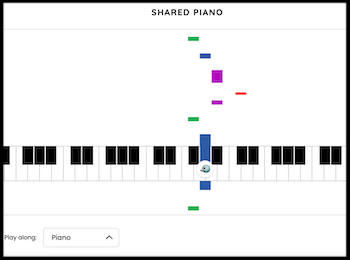 Review the three-sentence story, and then listen to three different examples of soundscapes (simple instruments, body percussion, Chrome Music Lab). Pause after each example and have students describe what they heard in the soundscape. Write their responses on the board.
Review the three-sentence story, and then listen to three different examples of soundscapes (simple instruments, body percussion, Chrome Music Lab). Pause after each example and have students describe what they heard in the soundscape. Write their responses on the board.
Teacher: How would you describe the sounds you heard? (instrument, body percussion, melody, and so on) Were the sounds high or low, fast or slow, loud or soft? Did you hear rhythmic patterns repeated? What were they?
After listening to all of the examples, ask students to decide which they are going to re-create as a class. Let students know it might not sound exactly the same as the example, but that’s okay. The goal is to let them experience creating a soundscape together. Show the video again for students to play along with, but turn the sound off, so the students are following along with the words, but are creating their own sounds. This should take less than three minutes.
Teacher: We are now going to create a new soundscape by changing three things from what we just played. What could we change? We could change the rhythm patterns used. We could add a melody by humming what we heard. We could use different instruments. We could change the tempo (how fast or slow we go). We could change the dynamics (how loud or soft).
Here are a few ideas to share with students for possible sounds to use in this soundscape:
- musical instruments
- unpitched percussion
- rhythm sticks
- shakers
- pitched percussion
- xylophone
- bells
- piano
- digital
- GarageBand
- Chrome music lab
- unpitched percussion
- body percussion
- clapping
- snapping
- stomping
- patting
- thumping
- found sounds
- tapping a pencil on a desk
- wadding up a piece of paper
- vocalizations
- whistle
- hum
- popping lips
- tongue clicks
- hiss
- growl
Teacher: What three things are we going to change?
Play one soundscape again, and have students include the changes the class decided on.
Writing a Three-Sentence Story
Teacher: Michael Goedel, when discussing the Hoop Dance, explained that the Hoop Dance relates to each of us. He said that like the bird’s journey, “through aging and experiences we discover our potential.” https://universe.byu.edu/2016/03/24/byu-living-legends-hoop-dancer-keeps-family-tradition-alive/
Teacher: We all have stories to tell about our own journeys. We are going to share those personal journeys by creating our own soundscapes, but first we are going to map out our story using the three-sentence story structure. Each of you will write your story in only three sentences. The clearer and more concise those sentences are, the better. In the first sentence, you should capture the audience's interest and introduce the character(s) and setting. The middle sentence then introduces a conflict where the character(s) has to do something, learn something, grow, change, or take a risk. This middle sentence also provides details about the character's progress towards a solution. The end sentence brings the story to a conclusion or resolves the action in some way. Now it’s time for you to write three sentences about a journey you have had or an imagined journey. What is a snapshot of your journey that you could tell in three sentences?
Display the success criteria on the board to help students remember what their stories should include.
- Sentence 1--Introduce the main character and setting.
- Sentence 2--Introduce one main problem.
- Sentence 3--Find a conclusion for the problem.
Give students time to create their individual stories.
Creating Individual Soundscapes
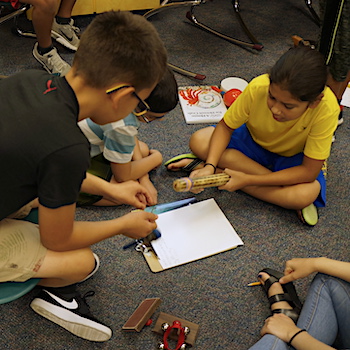
Have students use sounds available in the classroom to create their own soundscapes.
Once completed, students should perform their soundscapes by first reading their three sentences and then playing their soundscape.
Optional extensions:
- Have students spend the day paying attention to all of the sounds around them that they might be able to include in their soundscape.
- Make this a take home assignment where students can explore different sounds found around their home.
- Give students time to experiment with objects in the classroom to discover what sounds they make.
- Explore additional music written by Louis W. Ballard and other Native American composers.
Learning Objectives
- Read informational text and summarize it for others.
- Learn about Native American Hoop Dancing.
- Tell a story using music (soundscape).
- Write a three-sentence narrative.
Utah State Board of Education Standards
This lesson can be used to meet standards in many grades and subject areas. We will highlight one grade’s standards to give an example of application.
Grade 4 Music
- Standard 4.M.CR.1: Improvise rhythmic and melodic patterns and musical ideas.
- Standard 4.M.CR.2: Explain the connection of musical ideas to specific purpose and context.
- Standard 4.M.CR.4: Select and demonstrate musical ideas to express intent while connecting to purpose and context.
- Standard 4.M.CR.6: Evaluate and refine work; apply teacher-provided criteria and collaboratively developed guidelines and feedback; and present the final version of created music and describe connection to expressive intent.
- Standard 4.M.P.2: Explore the effects of various dynamic levels, tempos, and articulations.
- Standard 4.M.CO.1: Describe how music relates to personal, social, emotional, and intellectual development.
- Standard 4.M.CO.2: Draw upon interests, knowledge, and skills developed to inspire and inform the creation, performance, and appreciation of music, and deepen understanding of another content area through music.
- Standard 4.M.CO.3: Experience and explore music which connects us to history, culture, heritage, and community, and identify connections between a music genre and cultural or historical contexts.
Grade 4 English Language Arts
- Standard 4.R.6: Read a variety of text types, including those from diverse cultures to determine a theme or main idea and explain how it is supported by key details; summarize texts using textual evidence. (RL & RI)
Standard 4.W.3: Write narrative pieces to develop real or imagined experiences or events using effective technique, descriptive details, clear event sequences, and provide a resolution.
Orient the reader by establishing a situation and introducing a narrator and/or characters; organize an event sequence that unfolds naturally.
Use dialogue and description to develop experiences and events or show the responses of characters to situations.
Use a variety of transitional words and phrases to manage the sequence of events.
Use concrete words, phrases, complex sentences, and sensory details to convey experiences and events precisely.
Use appropriate conventions when writing including text cohesion, sentence structure, and phrasing.
Grade 4 Dance
- Standard 4.D.CO.1: Explain how the main idea of a dance is similar to or different from one’s own experiences, relationships, ideas, or perspectives.
- Standard 4.D.CO.4: Select and describe movements in a specific genre or style, and explain how the movements relate to the culture, society, historical period, or community from which the dance originated.
Grade 4 Social Studies
- Standard 4.5.6: Choose one of Utah’s cultural institutions and explain its historical significance as well as the cultural benefits to Utah families and our nation.
Equipment and Materials Needed
- Slides for entire lesson
- Hoop Dance Images Powerpoint
- BYU’s Living Legends video of Michael Goedel performing the Hoop Dance
- Jigsaw Hoop Dance Information Sheet
- Jigsaw Hoop Dance Graphic Organizer
- Map of Native lands
- Recording of “Bees” from Katcina Dances by Louis W. Ballard
- Recordings of example Hoop Dance soundscapes
- simple instruments
- simple instruments (with story subtitles)
- body percussion
- body percussion (with story subtitles)
- Chrome Music Lab
- Musical, body percussion, and/or found sound instruments
Video of Terry Goedel introducing his family's Hoop Dance story (optional)
Additional Resources
This lesson was created thanks to a grant from the National Endowment for the Arts and the Utah Division of Arts & Museums.
- Teacher resource information pages about Hoop Dancing by Mary Grace Johnson
Interview of Terry Goedel discussing Hoop Dancing
- An article with additional information about the Hoop Dance
- An article with additional information about Louis W. Ballard and other Native American composers
- Additional information about stereotypical Native American sounds
- Sounds, Stereotypes, and Structures that Silence
- Native American Le le le contest
- Answers about Native American ululation (le le)
Image References
Image 1: Terry Goedel
Image 2: BYU Living Legends
Image 3: Curtis Soderborg
Image 4: Screenshot from https://native-land.ca/
Image 5-6: Emily Soderborg

www.education.byu.edu/arts/lessons
 Download
Download